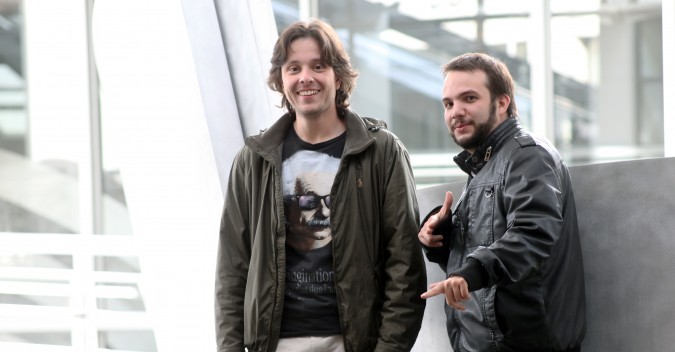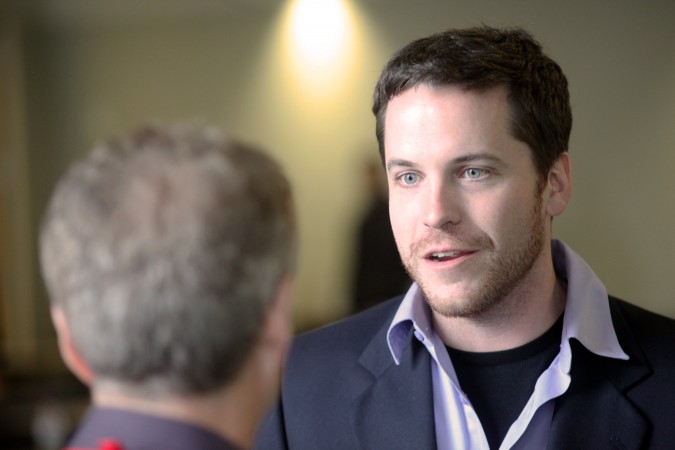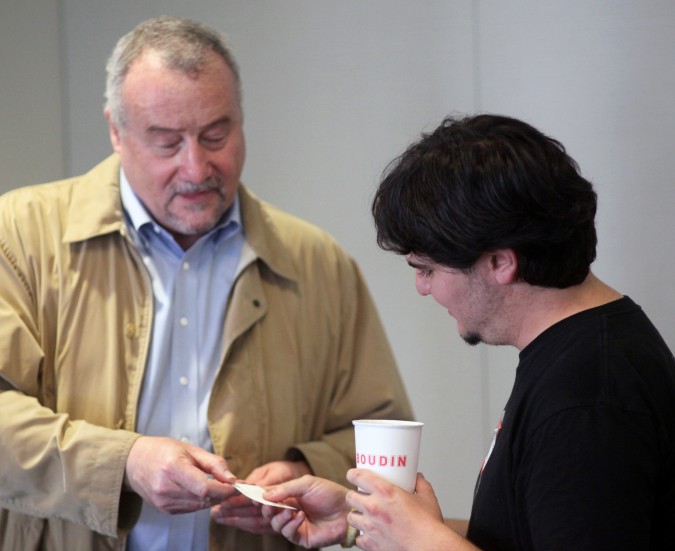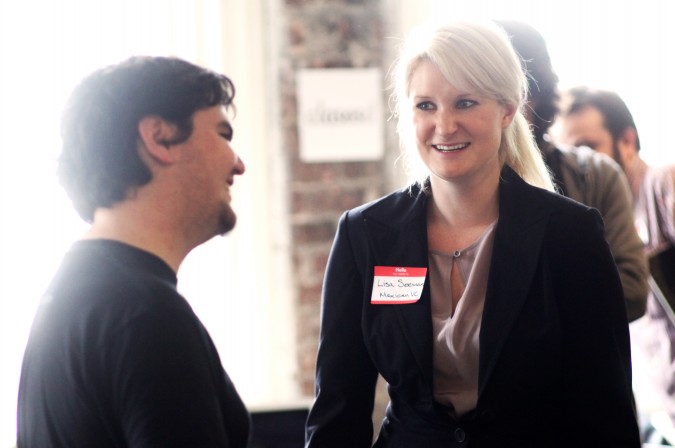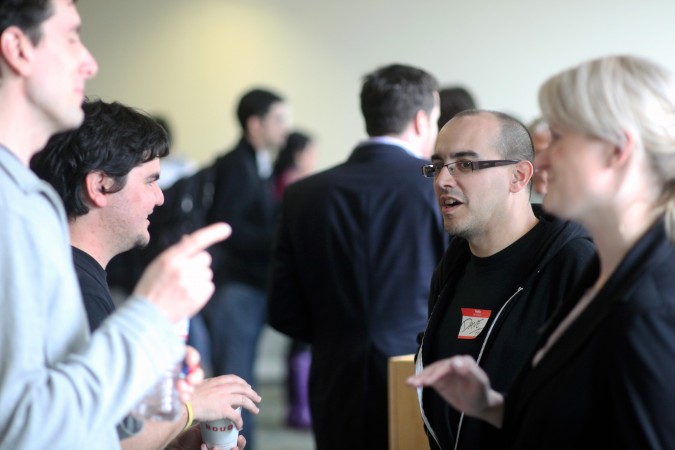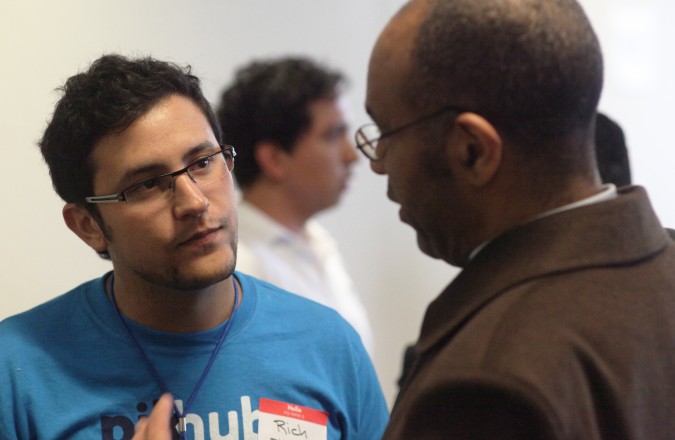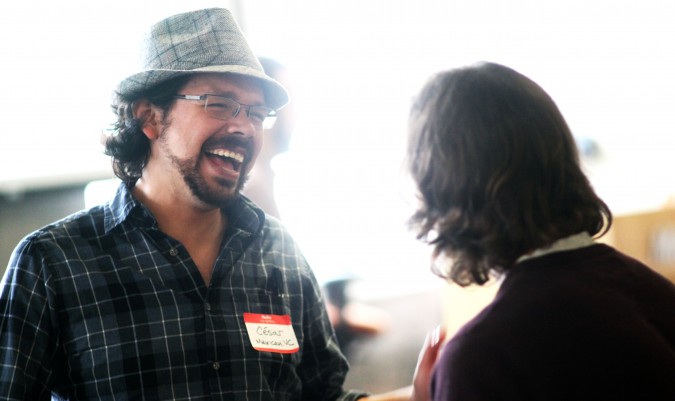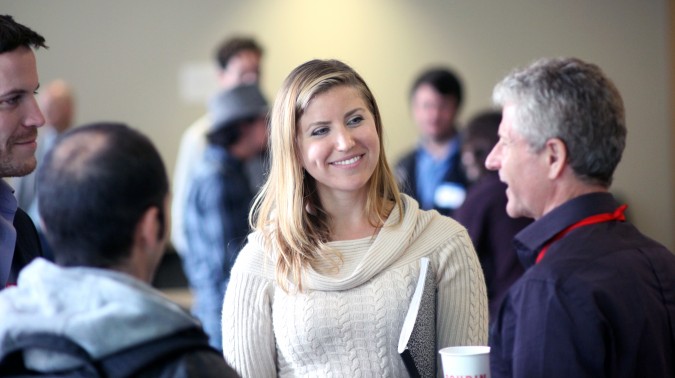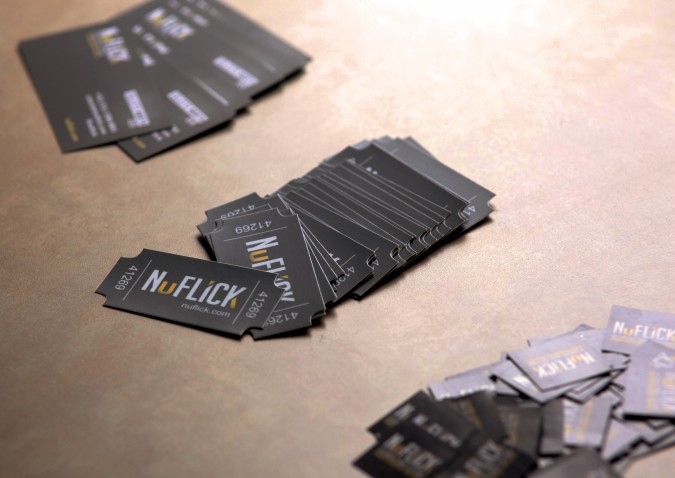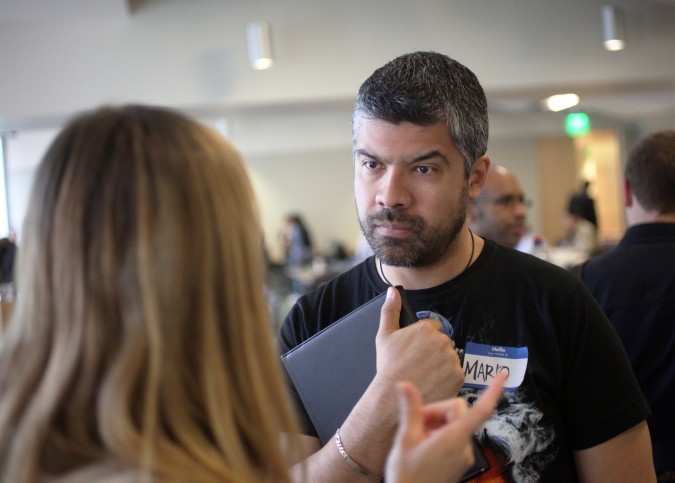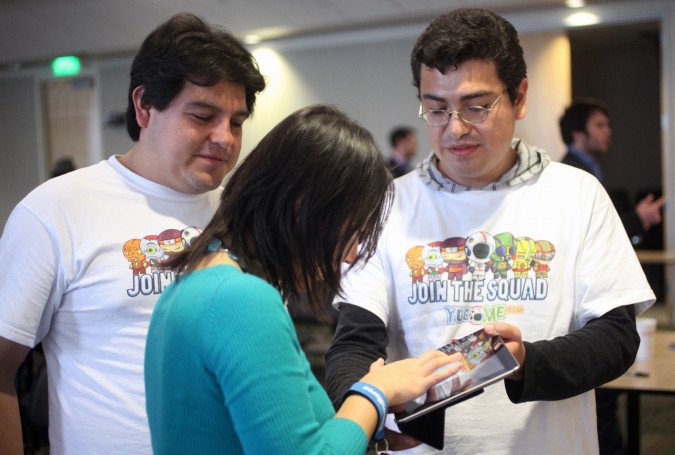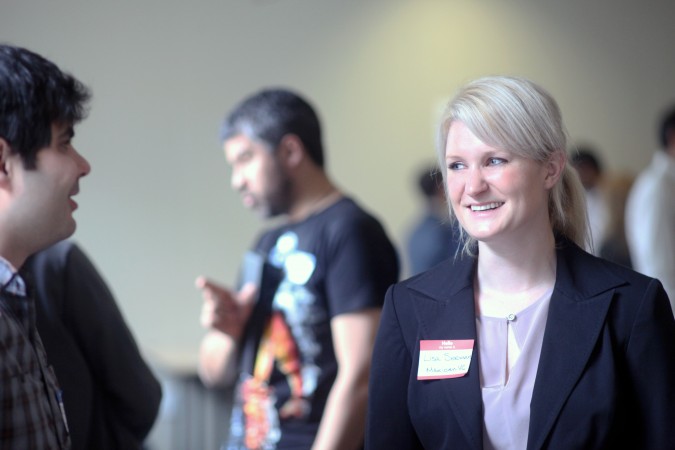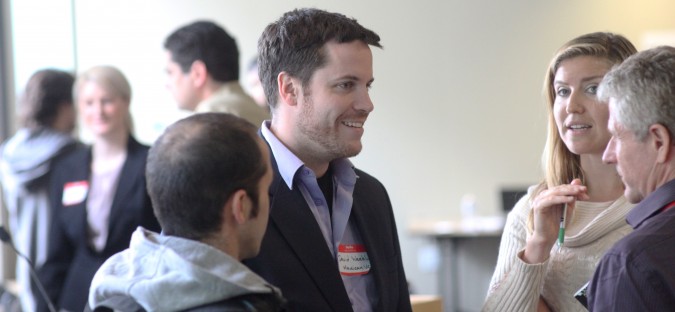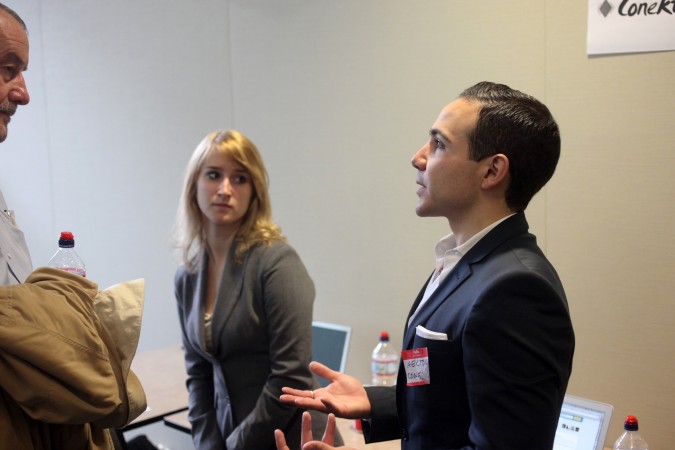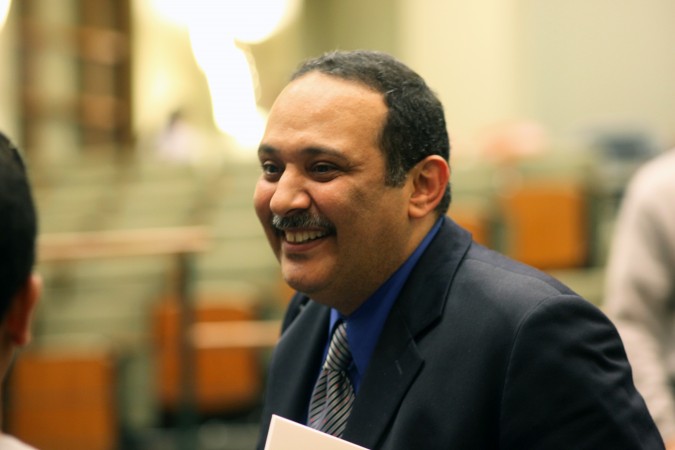Archive for the ‘Work’ Category
11,750,000.00, not 10,000,000.00
Last week I was doing some research on my first Internet company, Hotpaper.com, Inc. I discovered a report I had never seen before, from PrivCo Media, LLC. According to PrivCo’s report, I sold my company for USD $11,750,000.00, which is more than I knew. The published price was $10M, but I always knew the actual price was technically higher because the acquiring company didn’t cancel the stock options of my employees. I never really found out the exact value of that part of the compensation, since I left the company soon after the deal closed, and I never went hunting for the number.
ClasesD is SkillShare.com for Mexico
On Friday, March 16, 2012, I attended the first ‘graduation’ of the first ‘class’ of companies funded by the new seed stage venture capital firm mexican.vc. mexican.vc is run by four sharp General Partners — David Weekly, Santiago Zavala, Lisa Seeman and César Salazar.
mexican.vc has signed up prominent mentors to help, including Dave McClure, the founding partner of 500 Startups.
After the presentations, the teams dispersed around the conference room at Microsoft’s office at 835 Market Street in San Francisco, California USA. There were seven teams altogether. Three of the teams were set up along the left wall and three of the teams were set up against the right wall.
I introduced myself to and interviewed all those teams on Friday, and I wrote a long blog post about them that night.
What I didn’t know at the time was that the seventh team had set up their station up front in the room, where there was not a table, but a podium. That arrangement never registered with me that day, even though I had several lengthy conversations with people by that podium after the presentations. I didn’t know a team was there engaging with attendees. So that team, ClasesD, missed out on the commentary I wrote for my Friday blog post.
I was upset that I missed a team, so I wrote in that Friday post that I was willing to meet with the team I overlooked. The team found my blog post and reached out to me via my Facebook page.
I met the team yesterday afternoon, March 18, 2012, and we had an enjoyable meeting at the San Francisco Main Branch library at Civic Center in the City. I signed out one of the glass work rooms on the 4th floor so that we could talk without disturbing others.
Luis Enrique Aguilera and José Eduardo González described their company to me, and I had time to ask questions.
Before I get into my remarks, here is what the website for mexican.vc has to say about ClasesD:
“Interested in learning Spanish? Want to take yoga during your lunch break? You are in the right place! ClasesD is a marketplace for in-person lessons taught by independent professionals. Earlier this year when founder Eduardo was looking for dance lessons for his sister, he realized there must be a better way to advertise classes than flyers tacked on corkboards around town. Now, his team is helping people craving for knowledge find the right tutor in their city.”
Here are my comments about ClasesD:
ClasesD is SkillShare for Mexico. This is my observation, not something I heard from Aguilera or González. SkillShare is based in New York City, USA, and they have raised millions of dollars to pursue their business.
Although comparisons to airbnb have grown somewhat tiresome, such a comparison to ClasesD is inevitable. airbnb turned everyone that’s not homeless into a potential operator of a bed and breakfast. SkillShare and ClasesD turn everyone into a potential operator of a one teacher school.
If you’re a good cook, musician, painter, photographer, writer or mathematician, you can list your qualifications on ClasesD by creating a profile. Potential students can browse listings and read about the widely varied offerings. Of course, classes can be about anything, not just the example subjects I listed in this paragraph. Teachers set their own prices.
Students indicate their interest in a class and then the ClasesD website connects teacher and student together by telephone. This gives the teacher an opportunity to sell themselves to the student to increase the chances that prospects become customers. This highly personalized sales process might be unwieldy at scale, but I think it’s preferable in these early stages where the parties are still getting used to having an online marketplace to find each other in Mexico.
ClasesD makes money by charging a fee, currently 100 pesos (USD $7.93 at today’s exchange rate), to the teacher for providing the lead. Teachers keep all of the fee that they charge to attend their classes.
mexican.vc graduated 7 teams on Friday, including Fontacto. As I wrote in Friday’s post, Fontacto is Ring Central for Mexico. Fontacto helps small organizations appear big by offering a virtualized phone system that in its physical version is generally too costly to purchase and install at the organization. In a bit of portfolio company collaboration that would make any investor proud, ClasesD is a savvy consumer of Fontacto’s impressive telephony services.
One of the many impressive features offered by Fontacto is the ability to set up apparently numerous extensions on one physical telephone number.
ClasesD publishes a Fontacto powered phone number for students to call teachers on. Each teacher has an assigned extension number in the Fontacto system. Student’s calls are routed to the teacher, who can answer on whatever phone is most convenient at the time, including their mobile phone or their Skype connection. All the teacher’s assigned devices ring simultaneously, I presume, since that’s one of the features offered by Fontacto, and it makes sense to enable it for this application, where the students are probably most likely to become paying students if they reach the teacher on the first attempt.
ClasesD has a chicken and egg dilema — they need lots of teachers before they can get lots of students, but it’s tough to get lots of teachers until they have lots of students.
Marketplaces such as SkillShare and ClasesD are compelling to me. The operator of the marketplace does not have to stock and finance inventory. People expect to pay for services delivered through such marketplaces. The margins can be attractive given what needs to be done to operate the marketplace.
Aguilera and González struck me as passionate and determined. They’re learning quickly, and have tested several business models already on their search for the best model for Mexico. Their enthusiasm was evident from the moment they contacted me. I am not running TechCrunch, GigaOm or VentureBeat. I’m writing a personal blog. I will get perhaps 12,000 visitors to this site this month (I had 10,321 visitors in February, 2012). I still haven’t cracked the top million sites on Alexa. This is easy for others to check out. That Aguilera and González tracked me down and patiently explained their business to me to get a tiny amount of press shows to me that they are really trying to make ClasesD a success. They are well spoken and likable guys, and I wish them all the best.
My advice to them is to find a prove a business model that works, and then raise a million or more US dollars immediately to accelerate populating the site with more teachers and students. If you don’t solve the chicken and egg problem, a competitor will spring forth to do it for themselves, using your research to move more quickly.
Here are the biographical introductions for Aguilera and González, again from the mexican.vc website:
“Luis Enrique Aguilera graduated from ITESM Guadalajara with a B.S. in Business Administration. He is an entrepreneur, creative mind, and music aficionado. He is passionate about web marketing and SEO. He previously worked as a marketing and business consultant, which taught him to create powerful and innovative business models that he is eager to apply to his own startup.
José Eduardo González graduated from ITESM with a B.S. in Computer Science. Before founding ClasesD, he worked for 2 years as a Ruby on Rails developer in a startup called Inovaz (now a 500 startups company with their product Ovia), where he got his first taste of entrepreneurship and learned agile development practices.”
Aguilera and González graciously posed for pictures at the end of our meeting. I used the photogenic interior of the San Francisco Main Branch library as the backdrop. It was fun showing Aguilera and González around the library as this was their first visit. I attended the grand opening of the library on April 18, 1996, which featured a dramatic special delivery of the door key by skydiver Carl Prigee to Mayor Willie Brown after Prigee jumped from a biplane and landed right on target in front of the library, to the applause of the thousands gathered in attendance.
mexican.vc Demo Day, March 16, 2012 in San Francisco, California USA
This afternoon, March 16, 2012, I attended the Demo Day for the first graduating class of Internet startups funded by mexican.vc.
mexican.vc is a new seed stage venture capital firm based in Silicon Valley.
mexican.vc invests only in Internet companies that reside in Mexico.
mexican.vc currently invests USD $20,000 for 15% of the startups it accepts into its highly competitive program that includes mentorship, legal work and investor introductions.
mexican.vc is not an incubator and physical space is not provided to portfolio companies.
Portfolio companies are scattered throughout Mexico, which was a surprise to the general partners that run the brand new firm.
Some 75 teams applied for funding, but only seven firms were admitted to the first ‘class.’
Today’s ‘graduation’ of the first ‘class’ was an exciting thing to watch.
I attended because I am (barely) friends with David Weekly, one of the founders of mexico.vc, and via Facebook Weekly invited his friends to attend. I signed up as a blogger and brought my Canon 5D Mark II and a tripod to the event, held at Microsoft’s San Francisco office at 835 Market Street.
As a side note, I met Weekly soon after he co-founded Hacker Dojo in Mountain View, California. Weekly is a well known and well connected entrepreneur who writes a quality blog. While I was researching this story, I discovered that on March 8, 2012 Weekly advised non-technical Internet company startup founders to learn to program. Weekly said it’s essentially impossible to recruit a good technical cofounder to your company for no pay. I wrote a strongly worded blog post on March 11, 2012 giving the same advice to learn to program. I did not see Weekly’s outstanding post until today.
In part, Weekly writes:
“Napster was Shawn Fanning’s first Windows program – he was teaching himself how to code on his uncle’s couch so the early betas had lots of atrocious bugs. The company didn’t need a longstanding Windows expert to put the tech together, it needed someone who was willing to put in the elbow grease to figure out how to do it. In other words if you’re looking for a technical cofounder consider becoming one. It’s just too hard to find random technical people who don’t know you, are highly competent, and are happy to work for no pay and very little equity on your idea. (surprise!)”
I know I am writing a post about mexican.vc and not startups generally, but this is such a great quote and such a great opportunity to print it that I couldn’t resist. Napster was one of the most significant programs of the Internet age, and I learned from David Weekly tonight that the creator of Napster was not a Windows programmer before he coded the Windows version of Napster! I don’t know if Fanning was a programmer of other languages prior to this effort. But even so, my advice and Weekly’s advice is worth listening to. Learn to program, even if you plan to be the Barista, CFO, Janitor, CEO, Office Manager or Administrative Assistant.
Your life will only improve if you can also program.
Now back to mexican.vc’s Demo Day.
Here are the summaries word for word from the mexican.vc website of the companies I saw present today.
I will indent the official summaries. Then I will write my comments on that team and their product.
What mexican.vc says on its website about Yogome:
“This small team of brilliant hackers and designers is building better educational games for K-12 children mainly on the iOS (iPhone & iPad) platform. They are partnering with educational institutions to build fun, educational adventures that help kids learn more effectively. The characters in the game are superheroes fighting against the Queen Ignorantia.”
My comments on Yogome.com:
Yogome is my favorite of the companies I saw today. Their iPhone and iPad game is gorgeous. It looks like it was designed by a large game company, not three people that have been at it just a few months. Amazingly, this game today was the 10th most popular free educational downloadable application in the Apple App Store. It’s been zooming up in the rankings, jumping over 24,000% in the last week, according to a genuine hockey stick graph the team showed during their pitch. Even crazier, their app is number one in Thailand today in the same category.
Yogome plans to continue to give their apps away for free. They will make money by offering so-called ‘in app’ purchases where an existing player can upgrade after they have already discovered how wonderful the free app is. I like this strategy.
I persuaded Manolo Diaz of Yogome to show me one of Yogome’s games while I captured HD video. He narrates as he shows how to play the game, which teaches children to recycle by having them pickup apple cores, banana peels, bottles and cups and drop them in the correct recycle bin. Speed and accuracy are rewarded, and there is educational text at the end alerting players to what they learned and why it matters. The graphics in this game are lush, polished and delightful. Students play about half an hour per session, according to Diaz, indicating the games are engaging and fun.
What mexican.vc says on its website about Cactus:
“Through their initial startup experience, the team learned the ins and outs of the restaurant industry, both from the vendor and consumer perspectives. Cactus now offers a geo-aware mobile app that grants access to discounts in a growing network of restaurants. The basic app is free, giving users instant access to thousands of discounts. Moreover, users can upgrade to a premium subscription and enjoy substantially larger savings on every affiliated restaurant.”
My comments on Cactus:
This iPhone app looks well designed and smart. It’s not a Groupon like loser. Instead, it’s a phone enabled price discount system that gives restauranteurs real time analytics at the point of sale. A customer searches through a list of nearby eateries on their iPhone. When they find one they like, they show their phone screen to the cashier or waitperson, who enters the unique code on the screen into the Cactus website. The Cactus website then immediately tells the restaurant how many times the customer has eaten there via the Cactus system.
This personalization strikes me as very smart, and I can see restaurants being able to provide better service with this data so easily accessible. I predict such analytics will go a long way towards enticing reluctant restaurants to give Cactus a try.
I neglected to ask why they named their startup Cactus.
Free users of Cactus receive about a 10% discount and paid users receive about a 20% discount. Not bad.
What mexican.vc says on its website about ClassesD:
“Interested in learning Spanish? Want to take yoga during your lunch break? You are in the right place! ClasesD is a marketplace for in-person lessons taught by independent professionals. Earlier this year when founder Eduardo was looking for dance lessons for his sister, he realized there must be a better way to advertise classes than flyers tacked on corkboards around town. Now, his team is helping people craving for knowledge find the right tutor in their city.”
My comments on ClassesD:
I didn’t have a chance to visit with this team after their presentation. I simply didn’t see their table. I’m sorry about this, as I intended to and had time to see every team. If the team is still in town, I’d be happy to meet them to interview them so I can cover them as well.
What mexican.vc says on its website about Conekta:
“Conekta is a local business directory that allows users to find and share information about any type of business across Mexico, through both mobile and web platforms. Conekta focuses on making its information accurate and up to date to ensure users find what they are looking for.”
My comments on Conekta:
I love the premise of Conekta, which is to be a recommendation engine similar to Yelp, but tailored for the culture I was told is prevalent in Mexico. Apparently people in Mexico routinely friend on Facebook people they don’t know directly, but that their immediate friends do know. This means people have large friends lists. I was told people in Mexico distrust reviews written by complete strangers, but pay attention to reviews written by their Facebook friends, even if they don’t know them personally.
The clever approach by Conekta given the above is that the reviews are distributed within the loose confines of the Facebook friends system. Reviews are public so they can be found by search engines for purposes of search engine optimization. But reviews are filtered when viewed through the Conekta website so that users see just the reviews of their friends. This is brilliant I think. Conekta can attract new users because reviews will show up in Google search results. But once users are also Conekta customers, the list of reviews shrinks to those written by your friends. Users can follow reviewers that are not their friends, which allows for prolific and respected reviewers to build an audience and fan base. This is likely very helpful for people that don’t have many friends in their social networks.
What mexican.vc says on its website about NuFlick:
“Founded by hackers passionate about the independent movie industry (the primary founder was a filmmaker herself), Nuflick is trying to solve how independent movies are distributed on the Internet by building a platform to connect independent producers and films with viewers worldwide. Having been in the industry, the team understands the incentives of filmmakers and the limitations of conventional distributors, and we feel they have a real shot at disrupting the current system.”
My comments on NuFlick:
NuFlick is taking on an almost crazy challenge. They want to be the Netflix of independent movies. They are on track to have 500 movies available for streaming by May 2012. They are in Microsoft’s BizSpark program, and apparently Microsoft offers video streaming for free as part of their offerings to help young companies grow. This is a luxury and very generous of Microsoft. What gives me hope is the founders are passionate and are making progress. Their site is attractive, and their business cards are supremely clever. Their cards resemble old school tear apart movie tickets, before the industry went to custom printed tickets for each customer.
NuFlick is making enough waves that groups with catalogs of movies are now approaching them asking to distribute via their platform. This is flattering, and I hope NuFlick recognizes how lucky they are to have that happen at such an early stage in their development.
What mexican.vc says on its website about Fontacto:
“Intrigued by how to measure conversions on advertising that displays phone numbers, the Fontacto team started working on generating analytics around phone calls. In the processed they learned how these metrics show clients different ways to improve their marketing messages, their conversation rates and their phone sales/support process. Now, they’re bringing the power of VoIP to the long tail of small business entrepreneurs and independent professionals.”
My comments on Fontacto:
Fontacto is another exceptionally ambitious company, like NuFlick. Fontacto wants to be RingCentral for Mexico. Fontacto has built a working system and I am pretty certain they have customers already. I got a demo of the website, and it looks classy and smart. Users can choose their phone number and sign up entirely online. When calls come in to that number, Fontacto can ring multiple destination phones all at once. Skype is one of the supported destination phone types.
The most captivating feature for me was the ability for a recipient of a Fontacto call to transfer it to another Fontacto extension from the keypad.
Fontacto is not trying to be Google Voice, which is about individual users. I am a Google Voice user.
Fontacto is designed to allow small organizations to set up a big company sounding phone system, with mailboxes, auto attendant and routing of calls.
One nice touch is that you can elect to have Fontacto’s real human voice actors record your greetings so you don’t have to use your own voice. Right now this is included in the base price, though I learned this feature may become a premium feature.
What mexican.vc says on its website about pikhub:
“We all know how important events are for our social needs, however it’s still very difficult to find all the memories and interactions of an event in a single place. Pikhub is the place to gather everyone’s experience within an event. People can share and find all the pictures, attendees and interactions that happened there through a beautiful mobile experience.”
My comments on pikhub:
pikhub wants to be your picture hub. Today people go to events and then post them to albums they create on Facebook and Flickr. This results in numerous disconnected albums scattered over the Internet for big events like weddings, concerts and parties. pikhub would like all the attendees of sizable events to use pikhub as the central focus point for comprehensive coverage of sizable events.
pikhub is not trying to replace media storage on Flickr, Facebook or YouTube. They still want and expect people to store their actual media at those sites. The magic happens when pikhub users link to all the third party storage locations in a spoke like fashion where the center of the spokes converge at pikhub. This is cool because the spokes can lead to locations your friends control or locations controlled by people you don’t know and might never know, in the case of larger events like concerts, parades and marches.
I don’t follow this kind of company closely, so I don’t know if there are already similar sites in existence. If there are, please leave a comment alerting me.
Those are the seven companies that presented.
Impressive.
Keep in mind that there are essentially no seed stage venture capital firms in Mexico, according to the people inside and outside of mexican.vc that I interviewed for this story today. So the entrepreneurs in this first class are breaking new ground. They didn’t have peers nearby that they could ask questions of about the process of raising money from professional investors. This had to be intimidating to come to San Francisco to present in the offices of software giant Microsoft. Microsoft was kind to donate use of their very nice conference room on Market Street for this event.
I introduced myself to the three General Partners of mexican.vc that I hadn’t yet met. I had good conversations with all of them, and I came away feeling energized. These people are not your typical venture capitalists. They strike me as true entrepreneurs. I think they’ll be able to pull this off, because they seem to have a can do attitude for something I see as being very, very difficult — finding the gems in a huge, dispersed population in a country without a history in the Internet startup world.
For posterity, here are the biographies of the four General Partners in mexican.vc, which I copied from their exceptionally clean and understated website:
David Weekly — San Mateo, California USA
“David has been programming since he was five and has coded for MIT, Harvard, Stanford, There.com, atWeb, and Legato. David wrote the first layman’s description of MP3 in early 1997 and graduated in 2000 with a BS in Computer Science from Stanford, where he was a President Scholar and a finalist in the ACM International Programming Competition. David started the company that became PBworks in 2003. David cofounded SuperHappyDevHouse and HackerDojo. He has been a key promoter of hacker and startup culture in Silicon Valley and Mexico. He likes to throw hacker parties, fly helicopters, ride his motorcycle, and make useful things.”
Santiago Zavala — Mountain View, California USA
“Santiago has been programming and building stuff for a lifetime. He is a true hacker always trying to become a better hacker. Early in life he started an online community with thousands of users. After some years, we was a key player in the development of products such as Tikkia and DoingIt. Lately, he has been developing serious games at Innovations Games and not so serious game during his free time. Santiago is a cofounder of SuperHappyDevHouse Mexico City. He is also the editor of the weekly Hacker Digest newsletter.”
César Salazar — México, DF
“César has been a web developer and entrepreneur for almost 10 years now. During the last three years he has lead key efforts to empower the startup and hacker communities in Mexico. He specializes in User Experience Architecture and Product Engineering. He describes himself as a behavioralist, traveler and hacker culture practitioner, always interested in what makes people act the way we do. He is the original founder of 42 Claps. He is also one of the cofounders of SuperHappyDevHouse Mexico City and Hackspedition.”
Lisa Seeman — San Francisco, California USA
“Lisa is a born hacker and businesswoman. The daughter of two physicists, she received her BS with Honors in Electrical Engineering from the California Institute of Technology and was a National Science Foundation Graduate Research Fellow at Stanford University, earning her Masters in Electrical Engineering. Lisa was a management consultant at L.E.K. Consulting before becoming the first employee and Vice President of Engineering of IncentAlign, a sales optimization startup in Silicon Valley with business ties in China and Japan. Lisa has been a founder or team member of startups spanning the space of digital media, image recognition, sales optimization, and greentech.”
The event began at 2pm and it is now 3am the next day. I got home from the event at 7pm and began writing this post and editing the pictures and video I captured.
I hope that I made some new friends today. It was exhilarating to talk with so many interesting entrepreneurs. I stayed up late because I know people want to see these pictures. I uploaded them at full camera resolution of 21 megapixels. To see the full size versions, click on the pictures, wait for the huge version to load, and then click on it again to bring it to full size, which is larger than your screen.
I invite everybody I met today to friend me on Facebook.
Say hello. I would like to stay in touch.
Have an MBA and an idea? Looking for a technical co-founder to build it and join your unfunded startup for equity alone?
One of my highlights each month is serving as a mentor for the Haas Founders group.
Haas Founders is a group for Haas School of Business graduates from the University of California at Berkeley. It’s an invitation only group, but if you graduated from Haas you are quite likely to receive an invitation if you are a founder or co-founder of a startup company.
Another way in is to have a meaningful connection to the Haas School. That’s how I became a member. I have been a judge for the Berkeley Startup Competition from about 2004 through 2011.
Finally, all Haas graduates can buy their way in by agreeing to pay for the food and drinks. This allows service providers like bankers, investors and accountants to attend. Such service providers can meet ambitious startup founders that sometimes turn into clients.
I write the above to introduce you to the Haas Founders meeting. There is a Facebook page and a Twitter account for Haas Founders. Michael Berolzheimer moderates and organizes the Haas Founders meetings. Berolzheimer runs the genesis-stage venture firm Bee Partners which, according to his firm’s web site, pollinates visionary entrepreneurs with financial, human and social capital. Kishore Lakshminarayanan helps Berolzheimer set up the meetings, which take place at different venues each month, in the East Bay, South Bay and San Francisco, California USA. I met Berolzheimer in 2007, before he took on the responsibility for Haas Founders from the previous organizer, Mat Fogarty, CEO of Crowdcast.
Haas Founders has established a group on the professional social networking site Linked In. As of this morning there are 86 members. I believe the group is seeking new members, so if you fit the requirements, please introduce yourself to Michael Berolzheimer.
Haas Founders can be thought of as a board of directors like support group for startup founders, where no issues are off limits for discussion. That makes Haas Founders one of the most compelling meetings I’ve had the good fortune to attend.
I have attended the Haas Founders meetings since about 2005. Individual meetings are limited to 20 attendees.
This open forum for frank talk is made possible because attendees are asked to keep the the conversations confidential. To my knowledge, there has never been a meaningful breach of this rule. I think that’s a reflection of the trustworthiness and integrity of Haas students and graduates.
Given this secrecy, how can I write a blog post about Haas Founders?
Well, I am not going to discuss confidential information. The advice I am going to give is my own. I gave this advice to a participant at the most recent meeting March 6, 2012 in San Francisco.
I am not breaking confidentiality by repeating what I said that day because I have given this same advice many times without any restriction of confidentiality. It’s already public information. Problem averted. I ran this post by Berolzheimer before publishing it, as I want to be extra careful so as to not be uninvited to future meetings.
I decided to write this post because the issue I am going to talk about comes up so frequently that I have spent hours and hours answering this question over the years.
The question and answer are as follows:
Q: I am a non-technical founder and I have thought of a business idea that requires something technical be built. How do I find a talented technical co-founder to join my company for equity only to build my vision for me?
A: Forget it!
You can’t find a talented technical co-founder to join your unfunded idea stage company for equity only.
There are rare exceptions, but you can not count on them and should not consider counting on them.
One solution is to think of and pursue a business idea that you can implement with only the skills you have already. Here are three companies that I suspect began with little computer programming, for example:
- Become a mushroom farmer.
- Start a fair trade import company.
- Start a men’s fashion manufacturing company.
The smart people I suggest this answer to don’t quickly embrace my advice. That’s understandable. They are in love with their vision and they want to pursue that vision right now. They don’t want to hunt for a technically simpler business idea. They don’t want to learn the technical skills necessary to develop their original idea. They want a savior, a Steve Wozniak, to fall from the sky to do the real work of making a viable product. Usually such non-technical founders also want to reserve more of the company equity for themselves than for this savior, because they thought of the idea. If there is to be an equity disparity, I suggest it be weighted toward the technical contributors who make the product happen, not the non-technical people who think up the idea.
What non technical founders fail to appreciate is that talented technical individuals with the grit to want to start a company are in high demand. They are like supermodels in their desireability. A lot of people are asking them for dates. A lot of these suitors have lots of money to woo them with.
Why would a supermodel date a founder with no money when there is a line of suitors with six, seven or eight figure stacks of money at their side ready to spend?
The answer is supermodels don’t date broke founders.
Supermodels don’t hook up with unfunded MBAs that have a cool idea.
The perhaps sad truth is that MBAs are not held in high regard by many technical experts. This is not a comment on Berkeley MBAs, but on all MBAs. Of course, technical experts desperately need business experts at some point, as exits are rare for companies filled with only technical experts. I am not taking a stand on which type of person is more valuable because they are both vital. What I am saying is the technical people generally perceive that MBAs are not that important. If that’s the perception, then how can an MBA recruit a technical person without money?
There are millions of cool ideas to pursue at any moment. That’s always been the case and that will always be the case.
Talented technical people know they are in demand. They have recruiters calling them telling them so all the time. They read TechCrunch, VentureBeat and GigaOm. They know the technology world is in the middle of a full fledged boom right now. So only 2nd, 3rd, 4th and 5th rate technical people will agree to an equity only founder position with a non-technical sole co-founder.
The only practical exception is if you’ve already been friends with the person for years and they know your work and respect it. So classmates graduating together can get together and start a company, with some founders being non technical and some being technical.
But if you’re looking for a stranger to drop out of the sky to build your vision, you should forget it and focus on finding a simpler idea or on learning the technical skills yourself so you can build the first version of the product by yourself.
Yes, the product won’t likely have to polish of one created by a more seasoned expert, but it can be good enough. You only need it to be good enough to raise money that you can then use to pay a more skilled technical person to make an improved version.
I am not spouting off advice I read somewhere or heard somewhere — I know what I am talking about. Pardon me while I now go into extreme detail to convince you that I do know what I am talking about. What follows may seem like too much, but I have spent dozens and dozens of hours trying to beat this lesson into the heads of very smart non-technical company founders. I feel I need to pull out all the stops here to convince the skeptical that I am right.
I know it’s smart to learn to program because this is what I did to take my startup Hotpaper.com, Inc. from a USD $10,000 investment when I had almost no applicable skills through to a USD $10,000,000+ sale to a public company just six years later.
This is news I’ve written about more than once. But I haven’t described the grueling early work I put in that made this ‘quick success’ possible.
When I started Hotpaper, I was a minicomputer programmer. A Digital Equipment Coporation VAX minicomputer running Open VMS. There was nothing miniature about this computer. It filled an entire raised-floor water-cooled computer room and served 1,000 users in five offices in two US states. I believe it cost more than USD $12,000,000. Back then a 9 gigabyte disk drive cost USD $250,000. I saw the invoices and recall calculating the price per gigabyte.
When I started Hotpaper my only experience programming a PC was writing rudimentary DOS batch files. One can still write these for Windows, to run at a command window prompt. You can do amazing things with batch files, but you can’t write serious client-server or web applications with them. I had to learn to program graphical Microsoft Windows applications, and I had only used DOS on a PC up until that point. I had played for a few hours with a copy of Windows 3.1, but that was the extent of my experience with Windows. The one machine my employer had that ran Windows was so slow (Intel 386 with perhaps 1 megabyte of memory) that when you pressed a letter in a word processor (Ami Pro), there was a lag of about 1 full second before the character would show up on screen. It was pathetic.
I immediately bought a Hewlett Packard Pentium 60 Mhz computer with 4 megabytes of RAM and Windows 3.1 for Workgroups. I added Microsoft Office, which came on 30+ 3 1/2″ floppy disks, not a CD-ROM. This was a Pentium, not a Pentium II, III or IV. In fact, it was the slowest Pentium chip ever sold. But this was the fastest computer I had ever used. I still have it, in storage.
I all but shut myself off from the world for two years with hundreds of dollars of technical books, a 28.8K modem and a telephone. I taught myself to be an event driven computer programmer. Event driven programming is much different from the procedural programming I had done to program the huge VAX system run by my employer at the time, Cooley LLP. Yes, I knew how to program a little bit on a VAX, but Windows is so different that it’s almost as if I was learning to program from scratch.
Thankfully, Microsoft was not yet the market leader in word processing in 1994 since WordPerfect for DOS still dominated, so Microsoft tried very hard to persuade developers to embrace their Word word processing software. They offered free telephone technical support for programming problems, provided you paid for the phone call. There were no unlimited business phone lines back then, so my office phone bill was perhaps USD $100 a month due to all my calls to Microsoft — hours and hours of calls per month. I owe Microsoft so much for those calls, as they helped me to solve every problem I ever encountered. Thank you Microsoft.
Eventually Microsoft overnight switched from free technical support calls to USD $55.00 per incident technical support calls, and I had to stop calling them. But that was a couple of years later, and I had already gotten to be proficient by then, and I could get my questions answered for free on their well run newsgroups. By that point, Word and Office were the market leaders, and they didn’t need to try so hard to make developers embrace their tools.
I worked hard — really, really hard. I worked from about 10am to 10pm Monday through Saturday. On Sunday I wouldn’t come into the office until the mid afternoon, but I would still stay until 10pm or so. I did this from January 1995 through the end of 1996 or so, I believe. It took me that long to learn Windows programming reasonably well.
I didn’t know other software developers. There were no popular coworking spaces. Meetup didn’t exist. I was shy. But I was driven… really, powerfully and passionately driven. I had so little money I was living in a tiny studio apartment on Mason Street near Bush Street in San Francisco, California USA. My rent was USD $625 a month including utilities. I only owned one computer, so I could not work at home. I was at the office a lot, and it was just a seven minute walk to get there. I became really good friends with my office mates the late Stan Pasternak and patent attorney Robert Hill. I have such fond memories of that time.
Was the code I produced great? No. Was it awful? No. Was it reliable? Yes. Was it understandable to others? Yes. Did it get used by others for meaningful projects? Yes. Did I raise money with it? Yes. Did I sell the company successfully by following this model? Yes. Can you do the same? I think so.
At Hotpaper, I had a customer from the day I bought a computer. I told them I could build what they asked for. I actually had never done so on Windows. I had to figure out how to program Windows because I had a paying customer that demanded a Windows client-server based solution. They were paying me thousands so I had to deliver. I didn’t study for two years and then start to look for a client. I got the client based on my past reputation as a VAX programmer and then faked it until I made it.
It turns out that first project failed and the client never used my work or the work of any custom software developer.
They just bought an off the shelf application and conformed to its way of doing things.
But that’s irrelevant in the end. I got paid USD $30,000. I worked hard. The client made the best decision, for they should never have hired me or any developer when an off the shelf package was available for much less than having custom software written. I learned a lot, kept the rights to what I had built but did not get used, and I used that for the basis for what I then turned around and sold to Coca-Cola and the United States Department of Commerce, where it did get used on an enterprise scale.
Today it’s easier than ever to become a programmer. There are so many online tutorials like those from Codecademy. There are so many hacker co-working spaces like Hacker Dojo where you can base your new venture. You can work there as many hours as you can keep your eyes open, and there are smart people around much of the time to get help from.
Today all the software you need to do almost any project is free. That wasn’t the case in 1995, when now standard building blocks like MySQL hadn’t been popularized yet.
I have seen smart graduates spin their wheels for months or years trying to recruit a magical co-founder to build their product. How much better it would be for these people to sit down at Hacker Dojo and focus their considerable brain power on learning to program software directly. Even if the entire result is eventually rewritten later by someone more skilled, they would be better off than if they somehow found the mythical co-founder.
For once you know how to program in any language, you will be able to talk about and think about technical problems far more effectively than you can as a non programmer. It will be far more difficult for people to confuse, mislead or bamboozle you. You will be able to hire better programmers who will respect you more. You will be able to tell programmers what to attempt with more clarity and conviction because you know at least something about their world.
You will have insight into a world that’s richly diverse and totally fascinating. Your life will improve even if you never make a penny from your venture.
Programming is not easy. It can be absurdly complicated and exasperating at times. That’s why new college graduates who know little about the real world of programming can still command pay approaching USD $100,000 to start.
I am just one modestly successful entrepreneur.
Before you become a programmer, ask some technical startup founders you trust and see if they agree with what I’ve written here. Remember, Steve Jobs got lucky with Steve Wozniak. Silicon Valley was a sleepy place back then compared to today. Go make your own luck by developing your technical skills. If you have an MBA, you presumably spent four years to get an undergraduate degree and two years to get a business degree. Spend two more years to become a programmer. Doctors spend more time studying before they complete their education, so view eight years of study as normal, not crazy or silly.
I love programming, and I am extremely grateful I spent those grueling early years just powering through the books and road blocks to learn to program.
I feel I can do nearly anything I can dream up.
That’s a powerful feeling I wouldn’t give up for anything.
Please subscribe to this blog by leaving your email address in the upper right corner. Please friend or subscribe to me on Facebook. Please follow me on Twitter.
9th anniversary for gOffice.com, my startup
My startup Silveroffice, Inc. (gOffice) is 9 years old today. I am so thankful I didn’t sell it to Google when they came calling in 2006.
Dan Rather’s big break
I’ve been a fan of Dan Rather for years. Today I came across a great video interview of Rather where he tells how he got his break into television news in New York working for CBS News.
It’s a great story.
Dan Rather in 1960 was working as the News Director at KHOU television, a station Rather says in the video below was at the time the fifth or sixth station in a three station [television] market in Houston, Texas.
Dan Rather grew up in Texas in hurricane country and had had a life long fascination with hurricanes, perhaps from being born in Wharton, Texas on the Texas coast.
When he saw in September 1961 reports of what appeared to be an extremely large hurricane heading towards the Gulf of Mexico, he convinced his skeptical Program Manager Cal Jones that he should go to Galveston, Texas to cover the pending disaster, named hurricane Carla. Although Rather was not a meteorologist, he predicted accurately that the hurricane, which reached a level 5, would hit Galveston. Rather argued that Galveston would be flooded and inaccessible once the hurricane hit, so he had to go there immediately. His boss reluctantly gave Rather and a television cameraman the permission to go there.
This was the first time that a hurricane had been covered live on television.
Rather was correct — the huge hurricane hit and no other television news crew was in Galveston. Rather’s live coverage, including live radar screen video with a clear plastic map of the Texas coastline on top of the radar screen, was so compelling that the National CBS News producers picked up the feed from KHOU TV. The National CBS signal was fed throughout the United States, putting Dan Rather on a big stage at the center of a big news story, as the hurricane was monstrous in size and sadly killed 43 people despite 500,000 people being evacuated.
When Rather returned to his little television news department where he was the only full time employee, the bosses at CBS News headquarters called and offered Rather a job in New York. Dan Rather accepted a job as a television news correspondent, and his path toward anchoring the CBS nightly news became more probable.
This story should provide insight for everyone with big aspirations in life.
For the most part, people make their own luck.
I think Dan Rather made his own luck in this case. He turned his personal interest in hurricanes into his big break. He recognized the advantage to being the only reporter at the scene of a very big story. He persuaded his skeptical boss at the time, who knew nothing about hurricanes, to send him into the danger zone. He performed well under pressure, and when approached by the bosses at CBS News headquarters, he apparently had the political skill to turn their interest into a job. Finally, he had the good sense to leave his job as News Director to become Correspondent, even though Correspondent was a huge reduction in title.
Sitting around waiting for your lucky break is unproductive.
Go make your own luck like Dan Rather did.
Although my success pales in comparison, I followed much the same formula when I turned getting fired from Cooley LLP into selling my response to that firing for an extremely low eight figures just six years later. I could have fallen into a depression and plodded through life upset that Cooley didn’t want my expertise despite the positive press coverage my work had been receiving. Instead, I worked hard to expand and perfect my expertise. I packaged up my expertise into an attractive package called a corporation, and sold it when a buyer was buying, despite that being uncool at the time. I did all this with determination and purpose, and predicted accurately that I would sell as soon as soon as it became practical. I became an angel investor and advisor to startups, while also starting a third company, which I continue to work on.
I am remaking myself in similar fashion right now after an even more debilitating setback than being fired, and I predict that I will show even more success this time around. Why? Because I am more confident, wise, connected and savvy than I was when I started my first company at age 23 and my second company at age 30.
I used to be so shy, a huge impediment to entrepreneurial success. Now I can strike up a conversation with anyone, anywhere — even on the bus, at a club or in line at the bank. I sure wish I could have done this when I was 18, for my life would have been much better. But I am thankful that I can do it now. If you can’t do this now, make it your mission to figure it out as soon as possible, even if you have to hire a coach and practice at great pain to yourself. It’s simply not that hard once you practice a little bit and leave your fear at the door. I haven’t had one bad experience starting a conversation. There are few skills more important than being able to confidently approach and strike up an enjoyable conversation with anyone, no matter what you want to do in life.
Wood pellet stove installs like a window air conditioner
Last week when I was in Oregon, USA visiting my 100 year old grandmother Elsie Battaglia, I stayed in Eugene for two nights, once on the way to Tigard, Oregon where Battaglia lives, and once on my way back home to my house in San Francisco, California.
I stayed in Eugene for two reasons:
The first reason was that my girlfriend Teanna Keller from when I was about 23 years old was from Eugene, and I have always wondered what that city was like. I worked at Newell Color Laboratory (since closed) back then with Jennifer Viksten, who I’m still in touch with thanks to the wonders of Facebook. I also worked at Newell with Hershel Klein, Bobby Ulloa and Shawn Renee Roberts.
The second reason is I have wanted for some time now to see a Cabela’s store in person. Patrick Nolan, a fellow bus enthusiast, introduced me to the Cabela’s catalog, and I was super intrigued when he showed it to me. The Cabela’s catalog is the old school Sears Catalog of fishing, boating, hunting, shooting and camping equipment.
I knew there was a Cabela’s opening up in Eugene because on my last drive to Tigard, this summer, I saw the billboards advertising the upcoming grand opening. The store is now open and I spent some time looking around.
I was shocked at how many models of hand guns they have on display. There were dozens of hand guns in glass cases, some over USD $1,500. There was a sign by the door advising people to declare their weapons upon entry to the store. Weapons were not prohibited to be carried into the store — Cabela’s just wanted you to tell them about them up front.
The store was big and lush, but its dedication to so many hand guns ruined it for me. I don’t see why hunters need handguns. Even if they do need handguns, do they need dozens of handguns?
One product that really caught my eye I discovered on the Cabela’s website. Have a look at this window mount wood pellet stove. It mounts in a window like an air conditioner. You plug it in to electricity and fill it with 30 pounds of wood pellets and you then can get up to 28,000 BTUs of heat out of it.
This product has the power to change lives, in my mind.
I used to go to Noisebridge, a hacking space in San Francisco somewhat similar to Hacker Dojo in Mountain View, California that I used to be a paid member of in its early days.
Hacker Dojo was too far away for me to visit regularly, and my romantic partner at the time hated me going down there to work because I spent less time with her at home. I investigated Noisebridge, and it showed promise, but the space is unheated. There is no natural gas service to the space, and the space is too large and too poorly insulated to economically heat with electricity. In the winter it’s so cold in Noisebridge you can see your breath and you have to wear a parka and gloves. This made it impossible for me to productively program, so I made other plans.
However, I still love the idea of Noisebridge, and I’m toying with the idea of joining if I can persuade the organizers to heat the space when it’s cold, which could be in the summer given the cool weather San Francisco is known for.
This pellet heater is portable and requires no chimney. That makes me believe that it may be installed just when needed, and without a building permit. I can see it might be impossible to get a permit at Noisebridge to install a fixed wood burning stove, as I rarely see wood stoves in commercial spaces.
At 28,000 BTUs, it would probably only take one or two of these stoves to fully heat the space, perhaps one at each end, where the windows are. Pellets can be delivered in truck load quantities for prices that are much lower than it would cost in electricity to produce comparable heat through resistance heating.
Noisebridge has a large freight elevator and lots of space, so taking deliveries of even tons of pellets would be practical. Their membership should increase if the space is kept warm and inviting. The increased membership fees will pay for a heater or two plus the pellets to feed them. The electricity this heater requires is to run the automated feed mechanism, a trivial amount of power. I understand their lease prohibits space heaters, but I suspect this window mount unit is not legally a ‘space heater.’ Since it’s mounted and secured in a window opening, it can’t be accidentally tipped over, and since it’s not at floor level, it’s more protected than a space heater would be.
I am hopeful Noisebridge will warm up to installing these heaters.
I will attend CloudBeat 2011, a cloud computing conference organized by VentureBeat
I plan to attend CloudBeat 2011 in Redwood City, California USA on November 30th and December 1st, 2011.
CloudBeat is an event put on by the website VentureBeat.
Since I’m in the process of moving the infrastructure for my company’s website to the cloud, I thought it would be a great idea to attend and make some new friends. If you’re also going to be there and would like to say hello, send me a message on Facebook, here.
I’ll be blogging about the event, so look for a report here.
Intel Capital Global Summit 2011 concluded yesterday
This week Intel Capital held its Global Summit for its Portfolio Companies. This event used to be called the Intel Capital CEO Summit, and I attended in 2008 and 2009 since my company Silveroffice, Inc. is an Intel Capital Portfolio Company. I did not attend this year because only select Portfolio Companies are invited, and I was not invited this year.
I am not upset or complaining however! Frankly, Silveroffice doesn’t deserve an invitation this year because it has been mostly dormant while I work on other projects in life.
I have committed to making Silveroffice a success, and I’m working on it strenuously again, for the first time in years. I have a renewed vision and passion for the company, one that will involve a complete rewrite of the software on a new platform. I am firing on all cylinders again after taking my foot off the accelerator for an extended period of deceleration.
I feel outstanding.
I remain in touch with people from Intel Capital, and perhaps one day I’ll be invited back to their Global Summit. But even if I’m not, I’ll fondly remember the fun I had at past events. In 2008 Intel Capital took over The Tonga Room restaurant at San Francisco’s Fairmont Hotel for breakfast, so I’ve eaten breakfast by The Tonga Room tropical lake, an unforgettable experience.
I got to meet and have several real conversations with musician and tech entrepreneur MC Hammer, in 2008 and 2009. In 2009 he remembered me from 2008. I’m certain of it because in 2009 I introduced my friend Gail Kantor, CEO of eJamming, also a Portfolio Company, to Hammer. Hammer looked at both of us and pointed at Kantor and said “You I haven’t met” and amazingly then pointed at me and said “You I have met.’ I only spoke with Hammer for perhaps 10 minutes the previous year, and we didn’t stay in touch, not even via social media. Hammer must meet thousands of people a year, and to be able to accurately remember me a year later after talking with me for such a short time was simply jaw dropping.
I recognize many tech entrepreneurs have met Hammer because he’s reputed to be a fixture at Silicon Valley events. But still it was fun to meet a real rock star and have dinner with him like I did in 2009.
I feel I let Intel Capital down by taking my foot off the Silveroffice, Inc. accelerator. They reached out to me to invite me to become a Portfolio Company. Part of my motivation to rebuild Silveroffice and make it a meaningful company again is to prove to Intel Capital that they did not misplace their confidence in me. This might seem like a silly reason, but I carefully debated accepting Intel Capital’s offer, and the negotiation of our deal took roughly a year to complete, so I have something invested, as do they. I started Silveroffice in 2003 so it is deeply a part of my life, and I enjoy working on it. Great things are to come, so stay tuned.
Silveroffice, Inc. doesn’t have a website, which is why the references above are not hyperlinks. Silveroffice created the first true online office suite, way back in 2004. It’s called gOffice. gOffice has been decimated in the marketplace by Google Apps and Zoho, but gOffice was number one in the world for over a year. If only some nice person would write a WikipediA entry for gOffice, I would be so pleased…
If you write a WikipediA entry, don’t overlook that Microsoft lists gOffice by name in its 10K Annual Report as a competitor to Microsoft Office from 2006 through 2010. In 2011 Microsoft stopped naming in its annual report any of its online competitors to Microsoft Office, so that’s why gOffice doesn’t appear in their 2011 report.
Intel Global Challenge 2011 at University of California at Berkeley
Yesterday evening, November 10, 2011, the 7th annual Intel Global Challenge final presentations were held in the Anderson Auditorium at the Haas School of Business on the University of California at Berkeley campus.
I took dozens of pictures, and I plan to write an extensive blog post later today. It’s 1:11 on 11/11/11 right now and I’m tired. But I’m posting a few highlights now to get something out. I’ll come back and fill out this post after I get some sleep.

